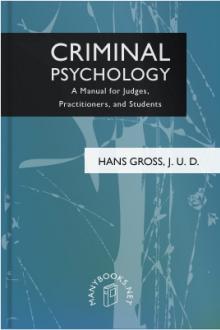Criminal Psychology by Hans Gross (best book recommendations .TXT) 📕

- Author: Hans Gross
- Performer: -
Book online «Criminal Psychology by Hans Gross (best book recommendations .TXT) 📕». Author Hans Gross
The illusions of hearing which completely normal people are subject to are the most difficult of all. Their number and frequency is variously estimated. The physician has nothing to do with them.
The physicist, the acoustician and physiologist do not care about the criminalist’s needs in this matter, and we ourselves rarely have time and opportunity to deal with it. As a result our information is very small, and no one can say how much is still undiscovered.
One of my friends has called my attention to the fact that when the beats of the clock are counted during sleepiness, one too many is regularly counted. I tested this observation and my experience confirmed it. If, now, we consider how frequently the determination of time makes the whole difference in a criminal case and how easily it is possible to mistake a whole hour, we can get some notion of the importance of this illusion. Its explanation is difficult and it may be merely a single instance of a whole series of unknown auditory illusions resting on the same basis. Another and similar phenomenon is the “double beat of the hammer.” If you have an assistant strike the table with a hammer while you hold both ears with your fingers and then open them half a second or a second after the blow, you hear the blow again. And if you open and shut your ears quickly you can hear the blow several times. This is explained through the fact that a number of reflections of the sound occur in the room, and that these are perceivable only by the unfatigued ear. The explanation is unsatisfactory because the experiment is sometimes successful in the open. Taken in itself, this matter seems very theoretical and without practical value. But this kind of action may occur <p 447>
automatically. It is well known that swallowing closes the Eustachian tubes for a moment, especially if done when lying down.
Now, if this occurs during a blow, a shot, etc., the sound must be heard twice. Again, it may easily happen that because of the noise a man wakes up half asleep and, frightened, swallows the collected saliva; then this accident, which in itself seems unimportant, may lead to very significant testimony. Such occurrences are not infrequent.
The intensity of a sound already heard may be of considerable influence. Certain experimenters have indicated the remarkable character of slightly intensive effects of sound. If you hold a watch so far from the ear as to hear it clearly but weakly, the sound decreases until finally it is not heard at all, and after awhile it is again heard, etc. This may lead to hearing distinct sounds made up of many tones, and need not evince any great illusion with regard to the ticking of a watch. But the thing may occur also in connection with more powerful and more distant sounds, e. g., the murmur of a brook, the rush of a train, the pounding in a distant factory. Noises far removed are influenced by reflections of sound, waves of air, etc., and it is possible that all kinds of things may be heard in a completely monotonous noise. This can be easily learned by listening to the soft murmur of a distant brook at night. Given the disposition and supposing the existence of the brook unknown, it is easy to hear in its monotonous murmur, human voices, sighs, shrieks, etc.
Another remarkable observation shows that in the dark very distinct things are heard during the playing of delicate instruments, such as mouth-organs. The humming approaches and withdraws, then it comes on various sides, and finally one has the feeling that the whole room is full of humming and winging insects. And this may go on indefinitely. There is a large collection of reasons for this reduplication of monotonous sounds. Everybody knows the accord of the <ae>olian harp which consists of identical notes, and the melodies which seem to lie in the pounding of the train on the rails.
This can become especially clear when one is half asleep. If ever thinking begins to be ousted by slumber, the rhythmic pound begins to dominate consciousness. Then the rhythm gets its appropriate melody which becomes progressively more intense, and if one grows suddenly wide awake one wonders why the clearly-heard music is missing. Similarly, it is often asserted that a row of travelling wild swans make pleasant chords, although each swan is able to utter <p 448>
only one cry. Difference in distance and alterations in the air cause the chords.
The difficulties in distinguishing the intensity or weakness of a sound are of importance. Fechner learned from the violinist Wasilewski that he observed that a male choir of four hundred voices did not sound essentially louder than one of two hundred. At the same time one clock is not heard at a great distance, a hundred clocks are heard. One locust can not be heard eating; when 1000 eat they are heard; hence each one must make a definite noise.[1] Early authorities have already indicated how difficult it is to distinguish the number of bells ringing together. Even musicians will often take two or three to be five or six.
Certain dispositions make some difference in this respect. The operating physician hears the low groaning of the patient after the operation without having heard his loud cries during the operation.
During the operation the physician must not hear anything that is likely to disturb his work, but the low groan has simply borne in upon him. The sleeping mother often is deaf to considerable noise, but wakes up immediately when her child draws a deeper breath than usual. Millers and factory hands, travellers, etc., do not hear the pounding of their various habitual environmental noises, but they perceive the slightest call, and everybody observes the considerable murmur of the world, the sum of all distant noises, only in the silence of the night that misses it.
Illusions of direction of sound are very common. It is said that even animals are subject to them; and everybody knows how few human beings can distinguish the source and direction of street music, a rolling wagon, or a ringing bell. Even when long practice enables one to determine direction with correctness, an accidental event, perhaps the weather, especial sounds, a different grouping of individuals on the street, may result in serious mistakes. I tried to learn to judge from my office-desk whether the ring of the horse-car came from above or below. I succeeded so well that I could not understand how it was difficult not to learn the difference, and yet I failed many a time altogether in judgment. The reason for it I do not know.
All these enumerated circumstances must show how very uncertain all acoustic perceptions are, and how little they may be trusted if they are not carefully tested under similar conditions, and if—what is most important—they are not isolated. We are here led back [1] Max Meyer: Zur Theorie der Ger<a:>uschempfindungen. Leipzig 1902.
<p 449>
to the old principle that every observation is not proof but means of proof, and that it may be trusted only when it is confirmed by many parallel actions which are really consistent. That even after that mistakes are possible, is true, but “after that” is when we have done all that lies within human power.
Section 101. (4) Illusions of Touch.
The high standing of the sense of touch which make it in certain directions even the organ of control of the sense of sight, is well known, and Condillac’s historic attempt to derive all the senses from this one is still plausible. If what is seen is to be seen accurately there is automatic resort to the confirmatory aid of the sense of touch, which apprehends what the eye has missed. Hence we find many people touching things, whose vision is not altogether reliable—
i. e., people of considerable age, children unpracticed in seeing, an uneducated people who have never learned to see quickly and comprehensively.
Moreover, certain things can be determined only by touching, i. e., the fineness of papers, cloth, etc., the sharpness or pointedness of instruments, or the rawness of objects. Even when we pat a dog kindly we do so partly because we want to see whether his skin is as smooth and fine as the eye sees it; moreover, we want to test the visual impression by that of touch.
But important and reliable as the sense of touch is, it is nevertheless not to be trusted when it is the sole instrument of perception.
We must never depend on the testimony of a witness based entirely on perceptions by touch, and the statements of a wounded person concerning the time, manner, etc., of his wound are unreliable unless he has also seen what he has felt. We know that most knife and bullet wounds, i. e., the most dangerous ones, are felt, in the first instance, as not very powerful blows. Blows on the extremities are not felt as such, but rather as pain, and blows on the head are regularly estimated in terms of pain, and falsely with regard to their strength. If they were powerful enough to cause unconsciousness they are said to have been very massive, but if they have not had that effect, they will be described by the most honest of witnesses as much more powerful than they actually were. Concerning the location of a wound in the back, in the side, even in the upper arm, the wounded person can give only general indications, and if he correctly indicates the seat of the wound, he has learned it later but did not know it when it occurred. According to Helmholtz, <p 450>
practically all abdominal sensations are attributed to the anterior abdominal wall. Now such matters become of importance when an individual has suffered several wounds in a brawl or an assault and wants to say certainly that he got wound A when X appeared, wound B when Y struck at him, etc. These assertions are almost all false because the victim is likely to identify the pain of the moment of receiving the wound with its later painfulness. If, for example, an individual has received a rather long but shallow knife wound and a deep stab in the back, the first will cause him very considerable burning sensation, the latter only the feeling of a heavy blow. Later on, at the examination, the cut has healed and is no longer painful; the dangerous stab which may have reached the lung, causes pain and great difficulty in breathing, so that the wounded man assigns the incidence of the stab to the painful sensation of the cut, and conversely.
Various perceptions of victims on receiving a wound are remarkable, and I have persuaded a police surgeon of considerable learning and originality to collect and interpret his great mass of material.
It is best done by means of tabulation, accurate description of wounds according to their place, size, form, and significance, the statement of the victim concerning his feeling at the moment of receiving the wound, the consequences of healing, and at the end explanatory observations concerning the reasons for true or incorrect sensations of the victim. As this work is to have only psychological value it is indifferent whether the victim is veracious or not. What we want to know is what people say about their perception. The true and the false will distinguish themselves automatically, the material being so





Comments (0)